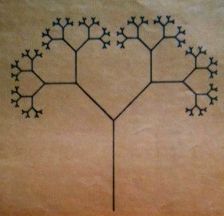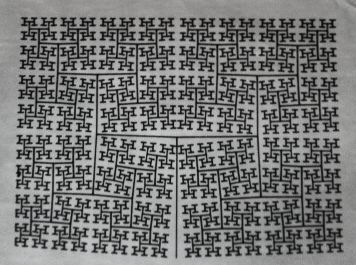
The History of Geom-e-TreeI had written a Pascal program that could draw binary trees. During a lab session I asked my students to experiment by varying several parameters. The computer would take a few moments to several minutes to draw a detailed tree on the screen. Remember, this was in 1978! Students tried various parameters, and soon started trying to make the fullest tree they could without overlapping branches. They discovered that different-angled trees needed different reduction factors (ratios) to make them "perfect". One student suggested that there must be a unique Perfect Reduction Factor (as we called it) for each angle. Soon after that lab I wrote a program to find the numbers that made perfect self-touching trees. After seeing that the special numbers did indeed produce perfect trees, the idea of making a full set of binary trees for 1° to 180° was not far behind. But so what? Print them on paper? Student David C. King took an interest and proposed an independent study to make an animated movie. He suggested that we could use a signal sent to the headphone jack of a "TONEBOX" attached to the TEKSCOPE to trigger a Super 8mm film camera that would take a single frame at a time. David worked in the computer center and he happened to know that the college had the single frame camera, and so on. He rigged up an electromagnetic relay that would push the camera's trigger. I wrote the program to produce a series of trees. The plan was that after each tree was drawn, the program would play a tone that would trigger the camera, and then the program would clear the screen to draw the next tree. After some tests of his relay, Dave was ready to put the camera on a tripod in front of the Tekscope. We'd start the program running in a locked dark room and come back hours later. Dave then took the film to be developed so we could watch the soundless movie on a projector. (This was the FILM era, not 8mm Video!) We repeated this a number of times to get the Geom-e-Tree Film (1980) you can now see on YouTube. Dave's enthusiasm for the project was endless.
 I showed Geom-e-Tree to the Math, Physics, and Biology faculty, to the college community, to family, and to friends at parties, but then the films sat in my desk drawer for many years. Interestingly, Geom-e-Tree was done at about the same time Mandelbrot was first discovering his famous fractal set. During the early Mac era, c.1986, I wrote a Rascal (Reed College Pascal) program and later featured a couple of those trees on my 1987 John Miller & Friends Calendar. Over the years, I wrote programs to draw trees using PostScript and to create GIF file output, including a 1300+ (?) frame animated GIF. I never put that animation on the Internet at the college or elsewhere because I figured it would use up too much bandwidth if it became popular. When David Cassard was taking a class in Java, I asked him to write a quick java-based version of geometree with sliders to control the angle and common ratio. You hit a REDRAW button after adjusting the parameters. I wrote the Geom-e-Tree app in November 2010 in response to the introduction of Apple's iPad. The iPad has provided the magic to make the trees come alive! It was fantastic to see the tree respond in real time. The Geom-e-Tree app will now allow many people to explore this space effortlessly, and also to collected specimens for later viewing. Version 1.0 is the beginning of a new chapter in the history of geometric trees. More recently, my son Gus created an HD version of the Geom-e-Tree sequence for a design project at Portland State University. |
ThanksIn December 2010, I convened two focus groups to review what I had at the time. Those groups advised me that the app needed the ability to save and share trees, rather than just having them confined to the display. The features in Version 1.0 are due to their input. The focus group members were: Martin Waugh, Andrew Burke, Greg Davis, Gus Miller, Greg Lind, Sue Gemmell, Erik Goetz, and Cynthia Stowell.Janine Ohmer was my technical support. She settled my exasperations when I got fouled up over Objective-C or the Interface Builder. I plunged into the project not knowing Objective-C, so there was a steep learning curve! Matt Blair, award-winning Portland App developer, gave me advice and moral support as I was putting Geom-e-Tree into the App Store for the first (and second!) time. August Miller, Portland State Graphics Design student, designed and executed the icons for the Geom-e-Tree and Geom-e-Twee apps, and two tab bar items. More importantly, he reviewed the user interface, typography, and the over-all look & feel a number of times during development. Gus held me accountable for what didn't work so well and pushed me beyond my own laziness or comfort zone to make Geom-e-Tree apps the classics that they are. Each time we met I came away with several refinements to the beta app and solutions to design issues that had stopped me.
John Miller |
EndnotesThe students at Lewis & Clark College were using TEKTRONIX 4010 series CRT terminals.. The TEKSCOPES could draw lines on green phosphor between any two points on the screen, but the screen had to be cleared completely to change what had already been drawn. See TEKTRONIX 4010 on Wikipedia.When a tree drawing was complete, the student could push a button to print the tree on expensive silver-coated paper. There was only one such printer on campus.

The computer was a VAX 11/780 running VMS. The terminals were connected at 2400 baud (bits/second). I may have had permission to boost the speed of the terminal line to 9600 baud to make the movie. I don't recall! On July 31, 2012, Dave King discovered the Geom-e-Tree video on YouTube, contacted me, and we have been back in touch, reminiscing about it and filling in the intervening 32 years! |
| Geom-e-Tree Home | Frequently Asked Questions |